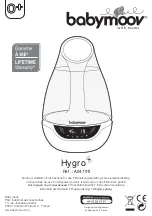
PAGE 2
2.1 LOCATION
The ability of a dryer to provide dry compressed air depends on the
correct location of the unit. Inlet air temperature and pressure are the
keys to selecting the proper location.
IMPORTANT
ALWAYS PROCESS AIR THROUGH THE DRYER AT THE
LOWEST POSSIBLE TEMPERATURE AND THE HIGHEST
PRACTICAL PRESSURE.
2.1-A INLET AIR TEMPERATURE
The dew point of the outlet air is directly related to the inlet air
temperature and the type of desiccant being used. The lower the inlet
temperature, the lower the dew point of the outlet air. Determine the
lowest ambient temperature where the compressed air is used or
where the lines are located. If you are using DRY-O-LITE or 10BF
desiccants, do not exceed 100
o
F inlet air temperature. If you are
using SP desiccant, do not exceed 80
o
F inlet air temperature.
2.1-B AFTERCOOLING
Air discharged by the compressor is extremely hot (from 150
o
F to
350
o
F). An aftercooler, finned tubing or extended run of piping will
usually be necessary to reduce the inlet air temperature to the dryer.
2.1-C OUTDOOR AIR USAGE
If some or all of the air supplied by the Van Air single tower dryer will
be used outdoors, install the dryer outdoors in the coolest possible
area. Make sure that the dryer is not exposed to ambient temperatures
below the minimum design temperature stamped on the vessel data
tag. When the dryer will be exposed to the direct rays of the sun,
install a sun shield to protect it (i.e. a roof).
2.1-D INDOOR AIR USAGE
If all of the air from the dryer will be used indoors where temperatures
remain within a fixed range, locate the dryer in the coolest indoor
area. When air equipment or piping is located in an air conditioned
area, install the dryer in the coolest area--usually the air conditioned
area.
2.1-E AIR RECEIVER
In relation to the air receiver, the Van Air single tower dryer should
be located where it will be provided with the coolest inlet temperature.
If the receiver is located in an area where the ambient temperature
is lower than the outlet air from the aftercooler, locate the dryer
downstream of the receiver to allow additional cooling of the air
before it enters the dryer. (Exception: In systems where usage
creates sudden demands on the air supply, locate dryer before the
receiver to minimize air surges through the dryer.) If the ambient
temperature around the receiver is higher than the outlet air
temperature from the aftercooler, locate the dryer between the
aftercooler and the receiver.
2.1-F SPECIAL EQUIPMENT INSTALLATION
If the Van Air Dryer is being installed on a branch line to protect a
specific piece of air-operated equipment, locate the dryer on the high
pressure side of any pressure regulators.
2.1-G OPERATING PRESSURE
More air can be processed through the dryer at higher pressures.
Locate the dryer at the highest practical pressure, but do not exceed
the maximum rated working pressure of the dryer. Refer to the
capacity chart located on Page 3 for the maximum working pressure
for your dryer.
2.2 PIPING AND ANCILLARY EQUIPMENT
Locate the dryer in the proper location as explained in the previous
section.
If the dryer is being installed in an existing piping system, make sure
that the pipe is free of scale and rust.
SECTION 2
INSTALLATION
SECTION 1
INTRODUCTION
1.0 PURPOSE OF OPERATION
The purpose of installing a Van Air single tower dryer in
a compressed air system is to remove the water vapor
(humidity) which has been drawn into the system at the
compressor intake. The Van Air process dries the air as
it flows through the vessel, which is filled with a special
drying agent. The dryer operates automatically. There
are no moving parts and no external source of power is
required. If an automatic drain is installed, a power
source is required only to operate the valve.
The wet air enters the centrally located inlet which
channels the flow into the lower portion of the dryer.
Liquid water and solid particles are separated by gravity
and fall to the bottom of the vessel.
The process air moves upward through the bed of
desiccant tablets which attract and absorb the moisture
from the air before it flows through the dryer outlet. The
tablets dissolve gradually as they absorb the moisture.
The tablets create a structured bed that does not crush
under its own weight. In the bed of an operating dryer,
the lower tablets are consumed first.
The tablets in the top portion are virtually unused and
serve as a reserve supply. When the reserve supply is
depleted, the dryer must be refilled to maintain
performance.
FIGURE 1 DRYER DETAILS
The solution, which consists of dissolved desiccant and water, falls
into the claim area at the bottom of the vessel. The dryer must be
drained at least once each shift to remove the accumulated solution.






























